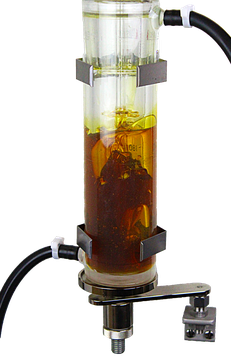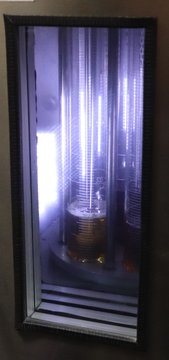
Air Separation - The Key Performance Indicator
The oil’s ability to separate entrained air is a key performance
indicator. The agitation of lubricating oil with air can lead to
aeration within the fluid, which can circulate through a lubricating
system. This mixture has the potential to impair the cooling effect,
compressibility, film strength, increase oxidation tendency, and
lead to cavitation, varnishing, and microdieseling. Arguably,
entrained air has the greatest potential to cause damage resulting
in poor hydraulic system performance or potentially even a
mechanical failure. Fast air release times are highly desired
because they improve equipment operation and allow the design
of smaller systems with higher circulation rates.
The Air Release Testing Method
ASTM D3427 Air Release Properties of Hydrocarbon Based Oils method is an important test for determining the ability of a turbine, gear, or hydraulic oil to separate entrained air. When assessing air release properties, the sample is heated to 25 °C, 50 °C or 75 °C (dependent on viscosity of the fluid at 40 °C) and compressed air is blown through the test oil. After the air flow is stopped, the time required for the air entrained in the oil to reduce in volume to 0.2% is the air release time.

Why is ASTM D3427 Air Release different from ASTM D892 Foaming Characteristics testing?
The air release test measures how quickly air bubbles rise and leave an oil sample, whereas the foam test is measuring the volume of air bubbles once they rise and gather at the top of the sample, and how long they last. The sample’s foam tendency (how much foam is generated) and foam stability (how long the foam lasts) is recorded during the foam test (tested at 24 °C and 93 °C).
The air release test forms larger bubbles than the foam test. The main difference is how the air is introduced into the sample. With the foam test, a porous, spherical stone diffuser is immersed at the bottom of the sample. The air release test uses an openended tube near the bottom of a tall cylindrical test vessel. The air flow is maintained at a specified back pressure and many large bubbles form and rise through the sample. The foaming characteristics of an oil can typically be improved by antifoam additives, which reduce the surface tension of the oil; air release cannot. The ability of an oil to release the entrained air is primarily a physical property of the oil itself.
Because Quality Matters
With the combination of Savant Labs’ expert analysts, state-of-the-art equipment and software, we are positioned to offer some of the most precise data found in the industry to date. Regular instrument calibration and maintenance to meticulous reference values and control chart monitoring is part of the quality regimen. In addition, all test results undergo a stringent quality review process and data is delivered on time and reported via email in a logical format designed for easy interpretation.
Additional Testing Needs
As a leading world class independent testing facility, our testing is conducted according to ASTM and other international standard test methods. Savant Labs has an expansive list of laboratory testing services. Should you have additional testing needs, please contact us.
